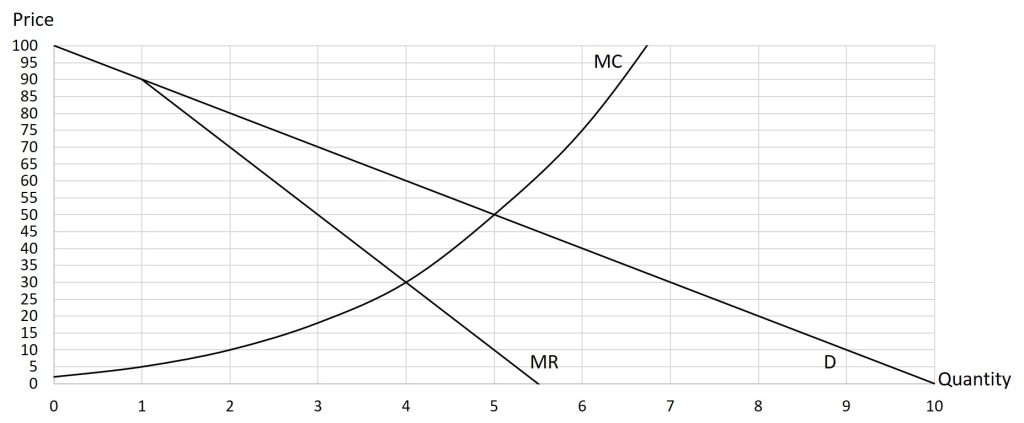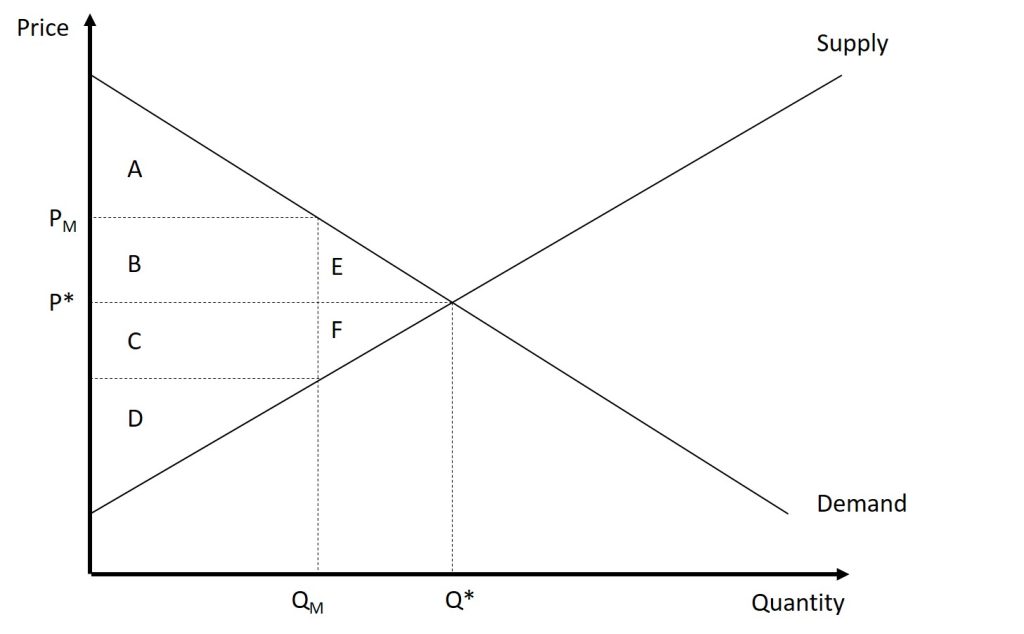8
8.1 an introduction to monopoly
Review Activities
No review activities for this section.
Problems
No problems for this section.
External Resources
Khan Academy: Perfect and Imperfect Competition
Khan Academy: Monopolies vs. Perfect Competition
8.2 barriers to entry
Review Activities
The original version of this chapter contained H5P content. You may want to remove or replace this element.
Problems
No problems for this section.
External Resources
No videos for this section.
8.3 monopolies and profit-maximization
Review Activities
The original version of this chapter contained H5P content. You may want to remove or replace this element.
Problems
Problem 8.3.1: A monopolist faces the following demand curve. Complete the table below.
| Q | P | TR | AR | MR |
| 0 | 30 | XX | XX | |
| 1 | 25 | |||
| 2 | 20 | |||
| 3 | 15 | |||
| 4 | 10 | |||
| 5 | 5 |
Solutions: $0; $25, $25, $25; $40, $20, $15; $45, $15, $5; $40, $10, -$5; $25, $5, $-15
Problem 8.3.2: A monopolist faces the following demand curve. Complete the table below.
| Q | P | TR | AR | MR |
| 0 | 30 | XX | XX | |
| 1 | 26 | |||
| 2 | 20 | |||
| 3 | 17 | |||
| 4 | 12 |
Solutions: $0; $26, $26, $26; $40, $20, $14; $51, $17, $11; $48, $12, -$3
Problem 8.3.3: A monopolist faces the following demand and cost schedules. Complete the table below. Find the profit-maximizing level of production as well as the profit-maximizing price. Be sure to use the profit-maximization condition. What is the maximum possible profit?
| Q | P | TR | TC | Tπ | MR | MC |
| 0 | 50 | 20 | ||||
| 1 | 45 | 25 | ||||
| 2 | 40 | 33 | ||||
| 3 | 35 | 45 | ||||
| 4 | 30 | 60 | ||||
| 5 | 25 | 80 | ||||
| 6 | 20 | 110 | ||||
| 7 | 15 | 150 | ||||
| 8 | 10 | 200 |
Solutions: See video for table. P=$30, Q=4, π=$60
Problem 8.3.4: A monopolist faces the following demand and cost schedules.
| Q | P | TR | TC | Tπ | MR | MC |
| 7 | 90 | 210 | ||||
| 8 | 87 | 230 | ||||
| 9 | 84 | 260 | ||||
| 10 | 81 | 300 | ||||
| 11 | 78 | 348 | ||||
| 12 | 74 | 408 | ||||
| 13 | 70 | 475 |
- Complete the table below.
- Find the profit-maximizing level of production as well as the profit-maximizing price. Be sure to use the profit-maximization condition. What is the maximum possible profit?
- Re-consider problems 1 and 2. Instead of a monopolist, the firm is now in a perfectly competitive market where the market price is $60. What is this firm’s profit-maximizing price and level of output? How much profit will it earn? Calculate the difference between the monopolist’s profit and the competitive firm’s profit. You do not need to make a new table, but can if you want to.
Solutions: See video for table; Q=11, P=$78, π=$510; P=$60, Q=12, π=$312, Monopolist earns $198 more than in PC.
Problem 8.3.5: Use the graph below to determine the profit-maximizing price and output for the monopolist.

Solution: Q=4, P=$60
Problem 8.3.6: Use the graph below to determine the profit-maximizing price and output for the monopolist.

Solution: Q=4, P=$18
External Resources
Khan Academy: Types of Competition and Marginal Revenue
Khan Academy: Marginal Revenue and Marginal Cost in Imperfect Competition
Khan Academy: Economic Profit for a Monopoly
Khan Academy: Monopolist Optimizing Price – Revenue
Khan Academy: Monopolist Optimizing Price – Marginal Revenue
Khan Academy: Review of Revenue and Cost Graphs for a Monopoly
8.4 The power and inefficiency of monopoly
Review Activities
The original version of this chapter contained H5P content. You may want to remove or replace this element.
Problems
Problem 8.4.1: Consider the market given below:

- What is the consumer surplus, producer surplus, total welfare, and deadweight loss when the market is in equilibrium.
- What is the consumer surplus, producer surplus, total welfare, and deadweight loss when a monopolist controls the market?
- How much consumer surplus was lost to the producers? How much consumer surplus was lost to the inefficiency of the market?
- How much producer surplus was transferred from the consumers? How much producer surplus was lost to the inefficiency of the market?
Solutions: CS=A+B+E, PS=C+D+F, TW=A+B+C+D+E+F, DWL=0; CS=A, PS=B+C+D, TW=A+B+C+D, DWL=E+F; Area B was consumer surplus but became producer surplus, Area E was consumer surplus but became DWL; Area B was consumer surplus that was transferred to producers and became producer surplus; producers lost area F to the inefficiency of the market.
Problem 8.4.2: Calculate the Lerner Index for the following situations. In addition, calculate the elasticity of demand.
- P=$3, MC=$2
- P=$6, MC=$6
- P=$15, MC=$3
Solutions: LI=0.33, εD=-3; LI=0 εD=-∞; LI=0.8 εD=-1.25
External Resources
Khan Academy: Monopolist Optimizing Price – Deadweight Loss
8.5 price discrimination
Review Activities
The original version of this chapter contained H5P content. You may want to remove or replace this element.
Problems
Problem 8.5.1: Suppose a monopolist faces the following demand schedule. Further, assume the marginal cost of production is constant at $10. Complete the tables below for both a single-price monopolist and a price discriminating monopolist.
Single-Price Monopolist
| Q | P | TR | TC | Tπ |
| 5 | 14 | |||
| 10 | 12 | |||
| 15 | 10 | |||
| 20 | 8 |
Price Discriminator
| Q | P | TR | TC | Tπ |
| 5 | 14 | |||
| 10 | 12 | |||
| 15 | 10 | |||
| 20 | 8 |
Solutions: See video for tables. For a single-price monopolist, greatest possible profit is $20. For a price discriminator, greatest possible profit is $30.
External Resources
Khan Academy: Price Discrimination
Khan Academy: Monopoly Price Discrimination
